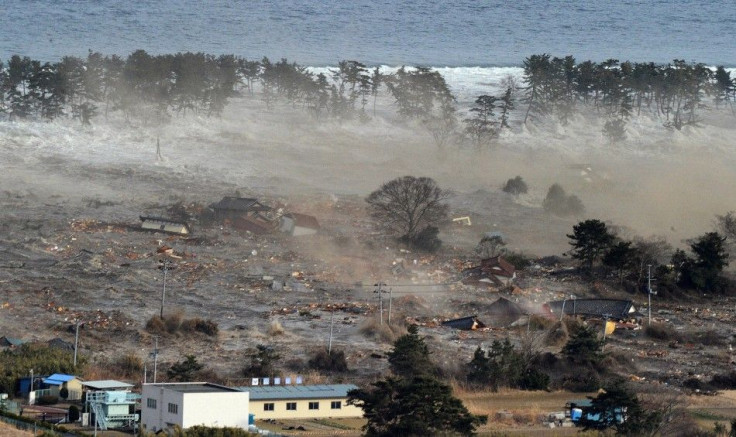How 8.9-magnitude earthquake shattered Japan, shocked the world on March 11, 2011

Japan was caught off guard Friday, March 11, 2011 by a devastating earthquake. The temblor measuring 8.9 in magnitude that struck Japan's Pacific Coast at 14:46 pm (0546 GMT) consequently triggered a monstrous 10-metre high tsunami besides landslides in some places, causing widespread damage and leaving scope for surging death tolls and causalities.
Unsuspecting civilians going about their daily routines were forced into a state of panic after they noticed buildings swaying from left to right.
For a few seconds, we stood there, looking at each other, noticing office building across from us moving from left to right. In a few seconds, the swaying became so violent we had to hold on to desk and chairs, Jacob Schlesinger recalled on a Wall Street Journal blog.
While some froze in fear, others rushed to open up ways towards safer grounds, said eye witnesses.
Meanwhile, at the Pacific Coast the quake had unleashed a massive tsunami that began its path of destruction by sending ships crashing into the shore. The wave carried cars through the streets of coastal towns and continued to make its way inward leading to inundation in northern coastal towns.
As the visuals of the havoc began to pour in floods of black water sent shipping containers, cars and debris crashing through towns. Aerial footage showed mud water racing upstream along the Natori river in Sendai city.
Fires broke out in various areas. TV footage showed smoke billowing out of a building in Odaiba, a Tokyo suburb industrial area in Yokohama's Isogo area and in Cosmo Oil Co.'s refinery near Tokyo.
As the earthquake continued to wreak havoc, internet flooded with ground reports from Japan. Social media lit up with reactions, prayers and timely updates of the disaster. While Facebook, Twitter and other social media platforms flooded with photos from people actually by the quake, YouTube users uploaded video footage giving viewers across the globe a glimpse into the first hand experience of the temblor.
Although the internet connections seems to have not abandoned Japan in its time of need, the phone lines were initially affected.
A mother, who was trying to reach home to her son, recounted the ordeal as she was stuck in traffic, The traffic has come to a standstill and I am unable to reach home. I received a call from my son and he told me that things fell off the shelves. I am very worried and the telephone is also not working now.
NTT DoCoMo Inc., KDDI Corp. and Softbank Corp., the three largest mobile-phone operators in Japan, said their services were disrupted across many regions, Businessweek reported.
While stagnant traffic made it impossible for those with vehicles to reach homes, public transporation system also came to a standstill.
Millions are stuck at work with no public transportation. Waves of Tsunami are washing away boats, cars, and houses, said an employee of a software firm.
The Japan earthquake also had a cascading effect across the dozens of countries in the 'Pacific Ring of Fire'. Countries such as Australia, New Zealand, Mexico, Peru, Chili, Guam, Taiwan, the Philippines, Indonesia as well as US state of Hawaii were put on Tsunami alert. Several other countries were also added to the list. NOAA's National Weather Service released a list of countries on the tsunami alert with the expected time of arrival. Evacuation efforts in the areas identified in the danger zone kick started.
Residents in Beijing also reported to have felt the tremors. However, a seismological official assured that the Chinese mainland is safe as the Japanese quake zone is separated by a sea area.
Due to the the magnitude of destruction, Japanese authorities struggled to assess the situation to even give estimates. The government just limited its assessment to words such as tremendous damage.
Our initial assessment indicates that there has already been enormous damage, chief government spokesman Yukio Edano said. We will make maximum relief effort based on that assessment.
After Prime Minister Naoto Kan assured that all of Japan's nuclear facilities were safe, and that there were no radiation leakages; a fire broke out in Miyagi Prefecture nuclear plant. However, no leaks have been reported so far. Japan's industry ministry shut down a total of 11 nuclear reactors at the Onagawa plant, Fukushima No. 1 and No. 2 plants and Tokai No. 2 plant.
As Japan continues reels under the after effects of one of the most severe earthquake to hit the country, the death toll continues to mount. A 67-year-old man was crushed by a wall and an elderly woman killed by a fallen roof in the wider Tokyo area, a schoolboy was swept away there by the deadly waters near Sendai in Miyagi prefecture, reported Japan press giving individual accounts of how the disaster claimed lives.
The March 11, 2011 earthquake has been dubbed as one of worst natural disaster that Japan has seen in decades. As it tries to rebuild itself, the country is expected to experience after-shocks for weeks.
© Copyright IBTimes 2024. All rights reserved.





















